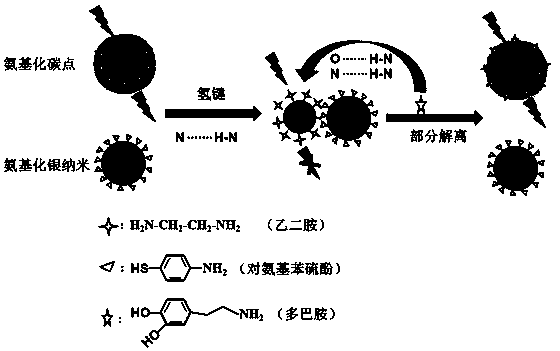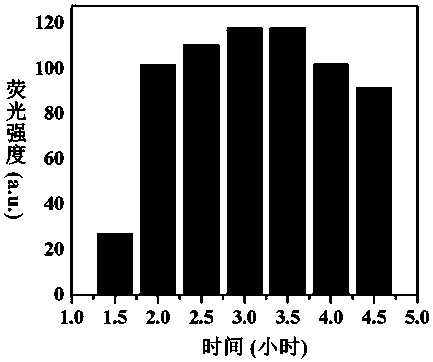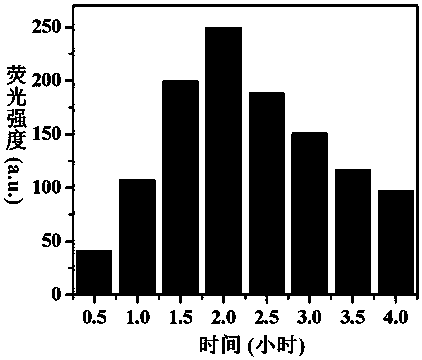Fluorescence sensor and preparation method and application thereof
A fluorescent sensor and reaction technology, applied in the field of fluorescent sensing, can solve the problems of expensive test equipment and low detection sensitivity, and achieve the effects of short detection time, good selectivity and great application prospects
- Summary
- Abstract
- Description
- Claims
- Application Information
AI Technical Summary
Problems solved by technology
Method used
Image
Examples
Embodiment 1
[0039] A fluorescent sensor in this embodiment, the fluorescent sensor is composed of a nanocomposite composed of aminated carbon quantum dots (N-CQDs) and p-aminothiophenol-modified silver nanoparticles (N-AgNPs).
[0040] A method for preparing a fluorescent sensor of the present embodiment comprises the following steps:
[0041] (1) Preparation of amidated carbon quantum dots (N-CQDs)
[0042] Weigh 0.72g of glucose and place it in a round bottom flask, add 25mL of ultrapure water to dissolve it, put it into a vacuum drying oven after ultrasonication for 10min, heat at 200°C for 3h, and cool the orange-yellow viscous liquid obtained after the reaction naturally to room temperature, after centrifugation and filtration, dilute to 25mL with ultra-pure water, and the obtained yellow solution is the CQDs mother liquor; take 5mL of the CQDs mother liquor into a 50mL round-bottomed flask, add 100μL ethylenediamine to it, and put it into In a vacuum drying oven, heat at 200°C for ...
Embodiment 2
[0059] The application of a fluorescent sensor of this embodiment in the detection of dopamine in serum comprises the following steps:
[0060] (1) Detection of dopamine content in standard solution
[0061] Take 200 μL of 5 copies of the fluorescent sensor prepared in Example 1, add 1.0 mL of dopamine standard solution samples with concentration gradients of 1.65 nM, 10 nM, 50 nM, 100 nM, 150 nM, 250 nM and 325 nM respectively, and use PBS with a concentration of 10 nM pH=8.0 The buffer solution was fixed to 5.0mL, and after reacting for 12min, under the excitation of 401nm, the fluorescence spectrum of the dopamine standard solution sample was detected with a fluorescence spectrophotometer. According to the concentration of the standard solution sample and the fluorescence spectrum F / F 0 The relationship between establishes a standard working straight line; where F 0 Represents the original fluorescence of the fluorescent sensor itself, and F represents the fluorescence spe...
Embodiment 3
[0068] In order to further study the practical application of N-CQDs / N-AgNPs nanocomposites, dopamine standard sample solution was added to 4 clinical serum samples respectively, and the DA content in the serum after the addition was detected by the prepared fluorescent sensor , the test results are shown in Table 2.
[0069] Table 2 The results of the standard recovery experiment
[0070]
[0071] The results in Table 2 show that the recovery rate is 98.8-109.8%, and the relative standard deviation (RSD) is less than 3.0%, which has good accuracy. Based on the above results, it is indicated that the N-CQDs / N-AgNPs nanocomposite fluorescent sensor can be well applied to the detection of DA in serum, which provides better application potential for medical clinical analysis.
PUM
 Login to View More
Login to View More Abstract
Description
Claims
Application Information
 Login to View More
Login to View More - R&D
- Intellectual Property
- Life Sciences
- Materials
- Tech Scout
- Unparalleled Data Quality
- Higher Quality Content
- 60% Fewer Hallucinations
Browse by: Latest US Patents, China's latest patents, Technical Efficacy Thesaurus, Application Domain, Technology Topic, Popular Technical Reports.
© 2025 PatSnap. All rights reserved.Legal|Privacy policy|Modern Slavery Act Transparency Statement|Sitemap|About US| Contact US: help@patsnap.com



